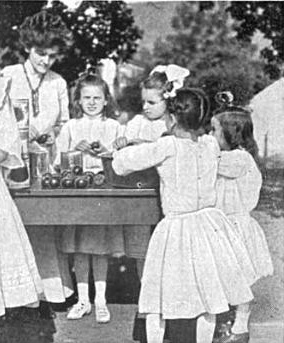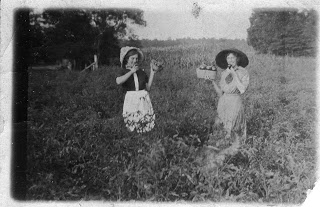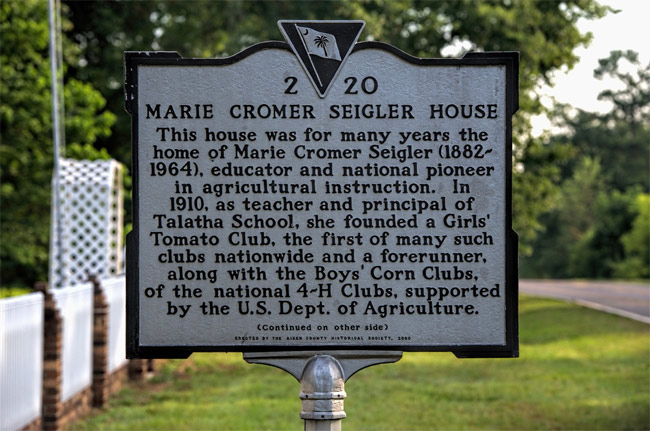“But what are we doing for the farm girls?” That was the question posed by Miss Marie Cromer, a country schoolteacher from Aiken county, at the South Carolina School Improvement Association Conference in December of 1909. O. B. Martin from the USDA was explaining how the boys’ corn clubs worked. This query might have been one of the first to address the issue of equity in agricultural education.

Marie Cromer
Once the need was seen by others, Cromer volunteered for the task of starting such a club for girls. She recruited forty-seven girls from the local community and the first tomato club was formed in the spring of 1910. Later the same year Virginia began a program in 2 or 3 counties under Ella Agnew. The following year, inspired by the experiences of the South Carolina and Virginia girls Alabama, Georgia, Mississippi, North Carolina, South Carolina, and Tennessee all started programs of their own (Martin, 1941; McKimmon, 1945).

Miss Cromer with the first girls club.
In the previous Friday Footnote, we learned that W. B. Otwell started corn growing contests in Illinois for boys in order to engage their fathers in Farmers Institute work. This effort soon spread to Farmers’ Institutes in other states. Soon schools were adopting the corn club idea in an effort to make schools more interesting and relevant. Then other groups jumped on the corn club bandwagon.
In 1907 boy’s corn clubs were started as part of the USDA farm demonstration work (True, 1929). The popularity of boy’s corn clubs grew rapidly and Dr. Knapp, appointed Professor O. B. Martin, a successful corn club supervisor from South Carolina, to be in charge of boys’ corn clubs in the South. Corn clubs were formed to educate and interest young boys and also to help pass information on more efficient farming methods to parents since the children were more receptive than the parents to change. The children would try new methods on a small plot and then the parents could see their effectiveness and implement the changes themselves. The work, in fact, revolutionized the way corn was farmed in the South.
Then, why were the tomato canning clubs formed? Not to innovate tomato growing or preservation, but because the girls saw what the boys were doing and wanted to get in on the action. These girls needed money, which they could make from the projects, for a variety of things that their families couldn’t spare the money for, but they also saw the boys were enjoying the activities and social opportunities that came from the corn clubs (McKimmon, 1945).
The tomato clubs provided a sense of camaraderie and even resulted in the development of cheers and songs. An example of a club song from Mississippi goes like this:
Tomato Club, Tomato Club
See how we Can, See how we Can
Give us tomatoes and a good sharp knife–
This is the place to get a good wife.
Did you ever see such girls in your life–
As the Tomato Club?
Such signs of unity as club songs resulted from the friendships that the girls found in fellow club members which alleviated the feelings of isolation.
How Did the Tomato Clubs Operate
Mr. Martin chose tomatoes as the primary vegetable for the new canning clubs. Tomatoes were chosen as the crop to grow not only because they were easy to grow and had a long growing season, but also for their ease of processing in rural conditions and their nutritional value including the presence of important vitamins (Moore, 2003). The focus on tomatoes was not implemented to make restrictions though, and it was expected that there would be some experimenting with other crops (Martin, 1941).
When the program was beginning in North Carolina, Jane McKimmon, the first state home demonstration agent, began as Mr. Martin did by approaching the superintendents in charge of public instruction in each state. In her own words McKimmon said that she did this because “If we expect to do anything at all, it would be necessary to secure the schools as meeting places and the teachers as co-operators” (1945, pg. 12).
Once the program began the problem of funding arose and the General Education Board that was already involved in the finances of the farm demonstration programs came to the rescue. In the end, the salary for the home demonstration agent positions was provided in large part by the General Education Board and some by the counties as well (Martin, 1941; McKimmon, 1945).
The organization of the tomato club is described in the Farm Life Readers, Book 5 (Bryan, Evans & Duncan, 1916, p. 38):
Any girl between the ages of nine and eighteen in the county, where the work is organized may become a member. She must plant one-tenth of an acre to tomatoes, and must do all the work connected with her garden except preparing the soil for her plants. Prizes are offered for the largest yield, the largest net gain, the best display in glass jars, best history of garden work, the largest tomato, the most perfect tomato, the largest, neatest best collection of tomato recipes.
The girls were expected to do all of the work in the production and canning of the tomatoes except for one task—they were not expected to actually plow the 1/10 acre of land. Since the plowing was done by mule or oxen at that point in time, it was determined that the father or someone else could turn the soil over for the girls. The Leon County (FL) 4-H web site provides more detail about the operation of the tomato clubs (Leon County, 2006):
Each girl planted and harvested tomatoes on a 1/10 acre plot. The tomato clubs were organized through the schools. The home garden and kitchen served as the laboratory. Home demonstration agents visited rural schools, talked about the tomato clubs, and left enrollment forms with the teachers. After getting their parents’ permission to join, the girls completed enrollment cards and mailed them to the home demonstration agent. The agent then sent tomato seed, planting instructions, and a record book to each enrolled member.
 Tomato club girls in NC tasting the tomatoes
Tomato club girls in NC tasting the tomatoes
What Were the Benefits of the Clubs?
The effects of club membership are difficult to measure because of the ripple effect of the clubs on the members and community. However, there were certain more immediate benefits that were readily apparent. To begin, the girls benefited from the skills they learned. Practices learned in the club included marketing, recordkeeping, disease and insect control, grading fruit, and obviously canning.

A 1912 tomato club exhibit in Florida
In addition to these canning crafts, many clubs also taught sewing, embroidery, crocheting and other home arts to the girls. Beyond these immediate effects of increased skills the girls and their families also benefited from improved nutrition, decreased isolation, and increased leadership abilities and opportunities.
Originally, the canning clubs were designed for the girls. However, mothers wanted to become involved in similar activities. So, similar types of activities including canning were started for the women, especially after the passage of the Smith-Lever Act in 1914 which contributed to the development of the home demonstration club movement (Engelhardt, 2009).
The tomato and canning clubs also promoted racial cooperation. McKimmon reports (1945) that white and black home demonstration agents shared information, worked closely together and taught each other lessons that they would then pass on to their constituencies. At first there were segregated training programs, but by 1933 the trainings were integrated so that “…a mutual feeling of respect and appreciation was engendered when each had an opportunity to hear reports of the other’s good work” (p. 145). Historian Glenda Gilmore (1996), after studying the tomato and canning clubs in North Carolina recognized that the relationships created were “..strong enough for black and white women to choose to continue to drive together down rutted roads, chatting about the work and their hopes for the future.” (p. 197). Even though social and legal Jim Crow separation was strong in the South, the tomato clubs helped overcome that separation.

African American tomato club members
Another major benefit of these clubs was the opportunity for women to develop their leadership skills. These clubs gave women a place to practice their leadership since members were encouraged to lead their own clubs which translated into leadership in their churches and other community roles as well. Especially in the South, which remained rural longer than the North, these organizations gave women a place for leadership growth and a place where they could accomplish more as a group than as spread out individuals (Howard & Kavenik, 2000). It was through the involvement in clubs and homemaker groups that the women not only bettered their work in the home since it remained in the women’s sphere, but also increased their confidence in accomplishments which led to expanding the sphere to include teaching, nursing, and social work as women’s work as well (Amott & Matthaei, 1996).
There is no better way to sum up what an opportunity it was for these girls than with a quote from Jane McKimmon, North Carolina’s state demonstration agent, “It wasn’t just canning; it was an opportunity to do something and to be something, and I have never regretted that the means provided for its accomplishment was a plain, everyday garden with which country girls were familiar” (McKimmon, 1945, pg. 25-26).
Conclusions
From the early days in South Carolina in 1910 through the great depression and beyond the tomato club was a powerful force for good. Tomato club success stories were featured in magazines and newspapers ranging from the Progressive Farmer to the New York Times. The tomato clubs promoted experiential education, taught agricultural concepts, provided the girls with spending money which was often spent on higher education, improved family nutrition, enhanced self-esteem, taught industrial food production concepts and promoted the used of modern technology, and even advanced interracial cooperation in a time of entrenched segregation. Perhaps it is time for agricultural and extension education to determine how this type of educational model could be used again today.

Teaching Ideas
The girls kept great records. In my opinion, the notebooks created by the girls were vastly superior to the records kept by the corn club boys. The North Carolina State University library has digitized hundreds of tomato club record books. They can be accessed at https://d.lib.ncsu.edu/collections/catalog (then search for tomato club notebooks) . Have your students select a record book and read it. Have your students determine what the tomato club girls learned from their projects and then report to the class.

Acknowledgment
Katie Pound, a former NCSU graduate student developed the first draft of this document and later presented it at the Southern Ag Ed Conference. The reference is Pound, K. & Moore, G. E. (2012, February). Achieving Equity for Females in Agricultural Education: The Development of Tomato Clubs. Paper presented at the American Association for Agricultural Education, Southern Region Conference. Birmingham, AL.
References
Amott, T. L., & Matthaei, J. (1996). Race, gender, and work: A multi-cultural economic history of women in the United States. Boston, MA: South End Press
Engelhardt, E. (2009). Canning tomatoes, growing “better and more perfect women”. Southern Cultures, 15 (4). Retrieved from http://muse.jhu.edu.www.lib.ncsu.edu:2048/journals/southern_cultures/v015/15.4.engelhardt.html.
Evans, L. B., Duncan, L. N. & Duncan, G. W. (1916). Farm Life Readers, Book 5. Boston: MA: Silver, Burdett & Company.
Gilmore, G. E. (1996). Gender and Jim Crow: Women and the Politics of White Supremacy in North Carolina, 1896-1920. Chapel Hill, NC: The University of North Carolina Press.
Howard, A. M., & Kavenik, F. M. (Eds.). (2000). Handbook of American women’s history (2nd Ed.). Thousand Oaks, CA: Sage Publications
Martin, O. B. (1941). The demonstration work (3rd Ed.). San Antonio, Texas: The Naylor Company.
McKimmon, J. S. (1945). When we’re green we grow. Chapel Hill, NC: The University of North Carolina Press.
Moore, D. (2003). Girl’s tomato clubs in Mississippi, 1911-1915. Retrieved from http://mshistory.k12.ms.us/articles/235/girls-tomato-clubs-in-mississippi-1911-1915
True, A. C. (1929). A history of agricultural education in the United States 1785-1925. Washington, DC: U.S. Government Printing Office.
Leon County 4-H History (2006), Retrieved from http://leon.ifas.ufl.edu/4-h_department/history/index.shtml
